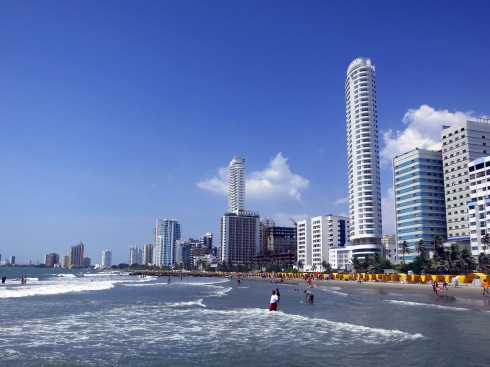
Warm, sunny Cartagena on the Pacific Ocean
One day almost two weeks ago I ate breakfast in La Paz, met up with friends Maike and J.J. for ceviche in Lima, and for dinner, shared late-night street sausages in Cartagena with the desk clerk at my hostel. Three meals in three different countries in one day, and when including dollars spent to pay airport taxes, expenditures in four currencies! My hopping around between Bolivia, Perú, and Colombia later warranted extra scrutiny from immigration, where I was flagged as an “alert”. No white powder here, officer…
Coming to Colombia was a spur-of-the-moment decision. After my friend Neil returned to the States, I spent an extra couple days bumming around La Paz before deciding a change of scenery was in order. Last-minute flights to Buenos Aires were too expensive, not even counting the $160 entry fee charged to U.S. citizens. A cheap flight to Rio de Janeiro was thwarted when I discovered that tourist visas could not be obtained at the airport upon arrival. But somehow I managed to find an open-jaw Colombian ticket, arriving in the northern beach town of Cartagena, departing from the capital city of Bogotá, and returning finally to Lima. I bought the tickets while eating lunch in a cafe in La Paz, and was off early the next morning for an all-too-brief visit to Colombia, where the tourism promotion campaign says “El riesgo es que te quieras quedar!” (English version: “The only risk is wanting to stay!”)
Cartagena de Indias
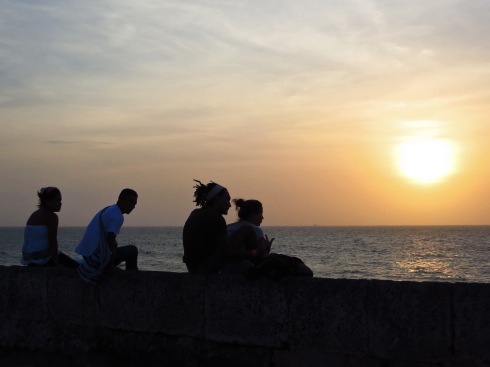
Sunset over the Pacific Ocean as seen from atop the old city’s walls at Cafe del Mar
Cartagena’s old walled city and fortress are a UNESCO World Heritage Site, although their beauty wasn’t immediately apparent when I arrived around midnight and found that the hotel I’d made a reservation at was full. As were a couple others nearby, so I was grateful to find a bare-bones hostel with a vacancy. The Getsemani neighborhood may be flush with tourists during the day, but at night, it has its sketchy parts. In a few square blocks, I walked past a number of drunks passed out on sidewalks, a gaggle of hookers and their pimp passing around a bottle, and saw cops with sirens flashing go by in three different directions.
I wound up staying up chatting with the hostel’s bored desk clerk, Samuel, actually 18, though he looked much older and bigger. The explanation for that came up when our conversation turned to baseball, and he told me two years ago he had been signed by the Orioles, who fed and trained him. (Of course, while in reality he never had a connection with the professional team, he likely was taken in by a buscone — a local talent scout with pro connections.) I listened with interest (and some difficulty, as the black Colombian Spanish accent was very different to my ears) as he described a life of rigorous daily workouts and running which he said transformed his body. But, sadly, Samuel broke his wrist and his dream of playing baseball was ended.
We talked about his favorite players, superstars like A-Rod and Pujols, as well as notable Colombians like Orlando Cabrera, although others were surprising (Angels’ rookie phenom Mike Trout, unheralded Mariners’ infielder Munenori Kawasaki). Despite his considerable knowledge of baseball, Samuel was less knowledgeable about other subjects, asking me whether Spanish was spoken in Perú, and if there were blacks there. I smiled when he proceeded to tell me that I was black. I started to explain about being of Indian descent, and how in Perú I was referred to as moreno (brown-skinned), but he cut me off, insisting “No, you are black, we are equal.” We pounded fists to that.

Enjoying a drink and the ocean view at Cafe del Mar
In the morning I moved to the beautiful commercial beachfront district of Bocanegra, where I was based for the next three days. I arrived exhausted to this oceanside resort town after a long two weeks of travel, and for me, Cartagena was the perfect place to relax and do little — I never made it out to the heralded Playa Blanca nor to the city’s club scene. Much of my time was spent frequenting beachside cafes, a cappuccino in hand in the morning, a cold cerveza in the afternoon as I read, wrote, and lounged. I noshed on arepas and fell in love with the humble side dish of arroz con coco (coconut rice), the perfect, slightly-sweet accompaniment to a freshly grilled fish.
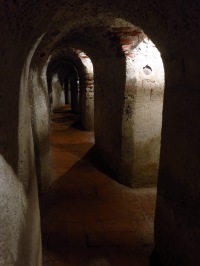
Eerie, empty tunnels at the Castillo San Felipe
Boasting a colonial old town and situated right on the Pacific Ocean, Cartagena boasts a number of terrific vantage points to catch great views. The best is at Cafe del Mar, a bar and patio located on top of the old city’s walls at its northernmost point. One side draws crowds every evening for a panorama of the sun setting over the water, while the other looks across the bay at the gleaming city skyline. It’s a view not to be missed.
Another is the view from the Castillo San Felipe, an old castle sitting on a hill prominently overlooking the historic part of town. It’s a cool old place to climb around, explore, and take photos; the castle also boasts a series of tunnels which you can wander through. As I arrived in the evening just before closing time, they were empty and actually spooky; when I happened to run into another couple around a dark corner, the woman screamed in terror!
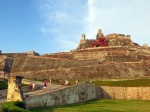 Castillo San Felipe |
 The “Volcán de Lodo” |
My strangest adventure, though, came outside the city. Some 40 minutes away lies a village community where a “mud volcano” — El Totumo, a small, 15m volcanic cone with a mud pool — attracts a number of tourists. I heard about this via word of mouth, and figured I had to try it out. It’s certainly a bizarre experience, as the site is kind of in the middle of nowhere, and there’s not much there. Everyone must strip down to their bathing suits and climb the short set of stairs to the mud pool. You enter the mud pool (after handing your camera to a designated local who will snap photos of you) and can relax in there for however long you want. Another set of locals, in the mud with you, offer to give massages. When you exit, you head off to the adjoining lake, strip naked, and wash off, while local village women help you bathe and clean your clothes.
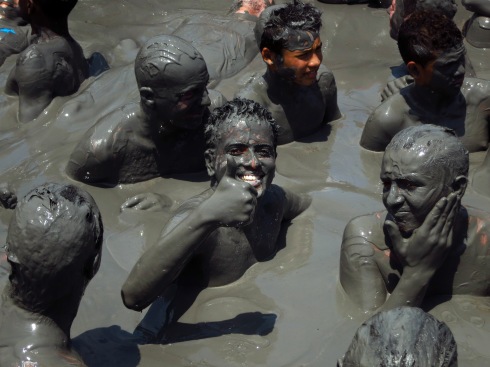
Me looking like the Swamp Thing
A Tale of Two Cities
As with Cartagena, I arrived at Bogotá late night, and thanks to last-minute planning found myself in a hostel in a dodgy part of the La Candelaria historic district. In fact, a taxi driver refused to take me there, while the second made me promise him multiples times not to go walking around the area. The hostel owner herself greeted me with instructions on which streets I was not to go walking on for safety reasons. Some introduction! I did in fact walk around a little that night, as I was starving, and confirmed that I was in a grim part of town. Bogotá, I fretted to my friend Rachelle (who had recently visited the city), was not as nice as I had thought.

Teleferico (cable car) at Monserrate, overlooking the entirety of Bogotá
Morning always bring a fresh perspective. I sought out the popular Cerro de Monserrate, the hill that towers over Bogotá. Although both a train and cable car run to the summit, I saw a hiking path, and of course had to hoof it. I might’ve reconsidered had I remembered that I was once again at high-altitude (Bogotá sits at over 2,600m or 8,600ft). Still, it was an hour-long hike with terrific views, so it didn’t sting too much that locals out for a stroll repeatedly breezed past me. Roughly two thousand feet later (signs posted on the trail posit this as a 2,000m climb, but I can’t get those numbers to add up to the posted elevation data), I was looking at a terrific panorama view — facing one direction, the entirety of the sprawling, 8-million-person metropolis of Bogotá, and in the other direction, dense alpine woods.
 Descending Monserrate in cable car |
 In the Plaza Bolivar |
The top of the hill, mobbed on weekends by locals and tourists alike, features a church and a couple of well-regarded restaurants. At the Casa San Isidro, I tucked into a Colombian mainstay: the hearty ajiaco soup. I eschewed the walk down (especially because it had turned cold and rainy at the summit) in favor of a 7,000 COP (~$4) ride on the teleférico (cable car). Upon alighting, I spent the rest of the afternoon walking around the historic district, taking in the Plaza Bolivar, Congress, and the cute, colorful colonial-style buildings that line the narrow streets there.
I knew I also had to see the city’s modern, upscale side. Luckily Bogotá has a system of clean, modern, easy-to-navigate buses called the Trans Millennium. (Its only problem is that it shuts down by 8 or 9pm.) I hopped on board one headed north, to the El Chapinero district, within which lie Bogota’s nicest streets. And indeed, from north of approximately Calle 80 between Avenidas 7 and 15 are dozens of blocks featuring a staggering variety of very good dining options, shopping malls, movie theaters, upscale boutique stores, and trendy bars and nightclubs filled with beautiful people. In this respect, Bogotá matches New York City, right down to the uber-high price tags.
If that Saturday night showed me Bogota’s glitzy side, Sunday morning (in the brief couple hours I had before heading to the airport) was the opposite — every Sun. from 7am to 2pm, many of Bogota’s major avenues and streets are closed for the Ciclovia, a city-wide program that draws tons of locals out to bicycle, rollerblade, jog, or walk along the streets. For a city of its size (only Mexico City and NYC are bigger in North America), it is cool to see something like this.
From this briefest of glimpses, I left assured that Bogotá could indeed be a pleasant place to live and work in the future.
The Last Supper
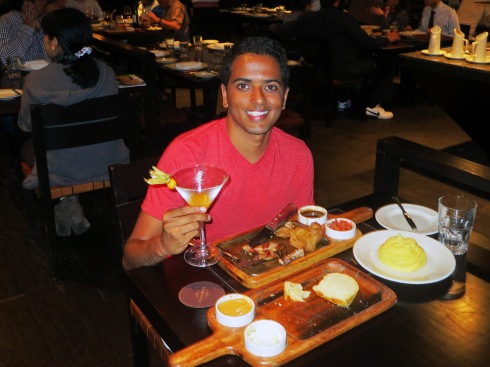
At the tail end of one of my most enjoyable meals ever — thank you, Panchita
These aren’t words I was looking to type, but I knew they would come eventually: my last day in Perú. As if to console me, it was a legitimately sunny and beautiful day in Lima, the rarity of which (outside of Dec-May) cannot be understated. Whatever disappointment I felt by the over-priced, overrated sushi I had for lunch at Osaka was swept away by the sublime last meal I had at what may now be my favorite restaurant in the world: Panchita.
Another offering in the Gaston Acurio empire, Panchita focuses on the great Peruvian grilled meat traditions. Given that my favorite foods in this country have been brochetas de pollo (chicken kebabs), anticuchos de corazón (sliced cow hearts), and chuletas de cerdo (pork chops), it was already a slam-dunk I would love this place. Great ambiance, great cocktails (oh, aguaymanto sour!), huge portions, and reasonable prices — absolutely perfect. I’m drooling just remembering dipping my meat into the spicy tomatillo sauce and the smoky barbecue sauce; the fresh foccacia and other breads with garlic butter and other dips; whipped, buttery mashed potatoes; the sweet, delicious baked apple. Perfect, filling comfort food in an elegant but unpretentious atmosphere.
To this restaurant, and of course to Perú — I will be back.







You dipped your meat in what? Ouch.
Check the spelling of those baseball names.
Your assessment is correct – Cartagena is the perfect place to rest and do little. One of my favorite cities.
Mm, I could go for some coconut rice.
If only you’d gotten a picture of the terrified woman in the tunnels 🙂
Haha, agreed. It was pretty dark and spooky there, and I prob exacerbated her reaction with my creepy whistling… this video should give you an idea: Tunnels of Castillo San Felipe
haha oh man, now i’ve got closing thoughts of chlone baby running through my head… nice!